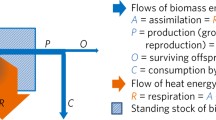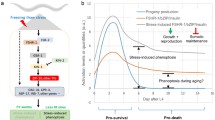Abstract
Evolutionary relationships among fitness traits are considered in terms of the near-to-universal scenario of stressful environments leading to a resource-deficient and hence energy-deficient world. Fitness approximates to energetic (and metabolic) efficiency under this environmental model. When fitness is high, stress resistance (reducible to oxidative-stress resistance) and metabolic stability are maximal, and energy expenditure is minimal. Rapid development should then be favored followed by a long lifespan and high adult survival. Positive associations among diverse fitness or life-history traits are expected, controlled by stress-resistant ‘good genotypes’. Heterozygotes tend to show higher energetic efficiency and hence higher fitness than do corresponding homozygotes under extreme environments, and to give parallel associations among life-history traits. Energy budgets under abiotic environments are pivotal for integrative evolutionary studies of life histories in natural populations.
Similar content being viewed by others
References
Arking R (1998) Biology of aging: observations and principles, 2nd edn. Sinauer Associates, Sunderland, Massachusetts
Arking R, Buck S, Hwangbo DS, Lane M (2002) Metabolic alterations and shifts in energy allocations are corequisites for the expression of extended longevity genes in Drosophila. Ann NY Acad Sci 959:251–262
Barja G (2004) Aging in vertebrates, and the effect of caloric restriction: a mitochondrial free radical production – DNA damage mechanism? Biol Rev 79:235–251
Criscuolo F, Gonzalez-Barroso M del M, Bouillard F, Ricquier D, Miroux B, Sorci G (2005) Mitochondrial uncoupling proteins: new perspectives for evolutionary ecologists. Am Nat 166:686–699
Demetrius L (2005) Of mice and men. EMBO Rep 6:S39–S44
Eldredge N (1999) The pattern of evolution. W H Freeman, New York
Falkowski PG (2006) Tracing oxygen’s imprint on Earth’s metabolic evolution. Science 311:1724–1725
Fisher RA (1930) The genetical theory of natural selection. Clarendon Press, Oxford
Hekimi S, Guarente L (2003) Genetics and the specificity of the aging process. Science 299:1351–1354
Hilliker AJ, Duyf B, Evans D, Phillips JP (1992) Urate-null rosy mutants of Drosophila melanogaster are hypersensitive to oxygen stress. Proc Natl Acad Sci USA 89:4243–4247
Kauffman SA (1993) The origins of order: self-organization and selection in evolution. Oxford Univ Press, New York
Koehn RK, Bayne BL (1989) Towards a physiological and genetical understanding of the stress response. Biol J Linn Soc 37:151–171
Kruuk LEB (2004) Estimating genetic parameters in natural populations using the animal model. Phil Trans Roy Soc Lond B359:873–890
Landis GN, Abdueva D, Skvortsov D, Yang J, Rabin BE, Carrick J, Tavaré S, Tower J (2004) Similar gene expression patterns characterize aging and oxidative stress in Drosophila melanogaster. Proc Natl Acad Sci USA 101:7663–7668
Margulis L, Sagan D (2002) Acquiring genomes: a theory of the origin of species. Basic Books, New York
Mauck RA, Huntingdon CE, Grubb TC Jr (2004) Age-specific reproductive success: evidence for the selection hypothesis. Evolution 58:880–885
Mitton JB (1993) Enzyme heterozygosity, metabolism and developmental variability. Genetica 89:47–63
Miyazaki S, Nevo E, Grishkan I, Idleman U, Weinberg D, Bohnert HJ (2003) Oxidative stress responses in yeast strains, Saccharomyces cerevisiae, from ‘Evolution Canyon’, Israel. Monatschefte für Chemie 134:1465–1480
Morowitz HJ (1992) Beginnings of cellular life: metabolism recaptures biogenesis. Yale Univ Press, New Haven
Myrand B, Tremblay R, Sévigny J-M (2002) Selection against blue mussels (Mytilus edulis L) homozygotes under various stressful conditions. J Hered 93:238–248
Nevo E (2001) Evolution of genome–phenome diversity under environmental stress. Proc Natl Acad Sci USA 98:6233–6240
Niewiarowski PH (2001) Energy budgets, growth rates, and thermal constraints: toward an integrative approach to the study of life-history variation. Am Nat 157:421–433
Olshansky SJ, Rattan SIS (2005) At the heart of aging: is it metabolic rate or stability? Biogerontology 6:291–295
Paolisso G, Tagliamonte MR, Risso MR, Manzella D, Gambardella A, Varrichio M (1998) Oxidative stress and advancing age: results in healthy centenarians. J␣Am Geriat Soc 46:833–838
Parsons PA (1971) Extreme-environment heterosis and genetic loads. Heredity 26:479–483
Parsons PA (1992) Evolutionary adaptation and stress: the fitness gradient. Evol Biol 26:191–223
Parsons PA (1995) Inherited stress resistance and longevity: a stress theory of ageing. Heredity 75:216–221
Parsons PA (1996) Rapid development and a long life: an association expected under a stress theory of aging. Experientia 53:643–646
Parsons PA (1998) Behavioral variability and limits to evolutionary adaptation under stress. Adv Study Behav 27:155–180
Parsons PA (2002) Life span: does the limit to survival depend upon metabolic efficiency under stress? Biogeronotology 3:233–241
Parsons PA (2004) From energy efficiency under stress to rapid development and a long life in natural populations. Biogerontology 5:201–210
Parsons PA (2005) Environments and evolution: interactions between stress, resource inadequacy and energetic efficiency. Biol Rev 80:589–610
Raymond J, Segre D (2006) The effect of oxygen on biochemical networks and the evolution of complex life. Science 311:1764–1767
Rosewell J, Shorrocks B (1987) The implication of survival rates in natural populations of Drosophila: capture–recapture experiments on domestic species. Biol J Linn Soc 32:373–384
Torres JL (1991) Natual selection and thermodynamic optimality. Il Nuovo Cimento 13:177–185
Van Voorhies WA, Fuchs J, Thomas S (2005) The longevity of Caenorhabditis elegans in soil. Biol Lett 1:247–249
Vernmeij GJ (2004) Nature: an economic history. Princeton Univ. Press, Princeton
Vorburger C (2005) Positive genetic correlations among major life-history traits related to ecological success in the aphid Myzus persicae. Evolution 59:1006–1015
Watt WB (1986) Power and efficiency as indexes of fitness in metabolic organization. Am Nat 127:629–653
Wedekind C (1994) Handicaps not obligatory in sexual selection for resistance genes. J Theor Biol 170:57–62
White TCR (1993) The inadequate environment: nitrogen and the abundance of animals. Springer-Verlag, Berlin
White TCR (2005) Why does the world stay green? Nutrition and survival of plant-eaters. CSIRO Publishing, Collingwood, Australia
Williams GC (1966) Adaptation and natural selection. Princeton University Press, Princeton
Zotin AI (1990) Thermodynamic bases of biological processes: physiological reactions and interactions. Walter de Gruyter, New York
Acknowledgement
The referees have improved the paper substantially for which I am most grateful.
Author information
Authors and Affiliations
Corresponding author
Rights and permissions
About this article
Cite this article
Parsons, P.A. Energetic efficiency under stress underlies positive genetic correlations between longevity and other fitness traits in natural populations. Biogerontology 8, 55–61 (2007). https://doi.org/10.1007/s10522-006-9028-8
Received:
Accepted:
Published:
Issue Date:
DOI: https://doi.org/10.1007/s10522-006-9028-8




